Cosmic discoveries are important because they expand our understanding of nature and allow us to test reality against our mathematical theories. Here are 10 objects which reach the extremes we need to test the limits of our calculations—and our imaginations.
宇宙探索极为重要,因为它不仅可以拓展人们对大自然的认知,而且人们可以利用它对数学理论进行验证。以下的十大物质考验了我们计算能力和想象力的极限。
10.最微小的行星
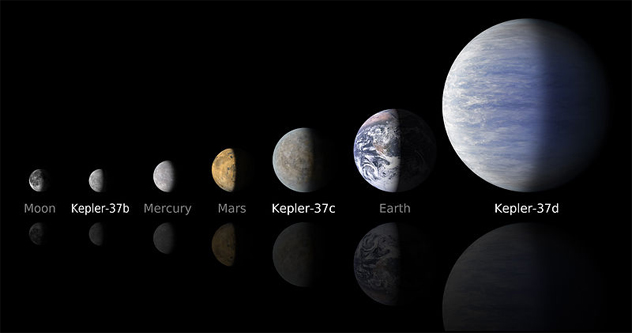
Earlier this year, the Kepler Observatory discovered a star system with three planets, including the smallest expolanet found to date. The Kepler telescope is conveniently located in space, allowing it an unobstructed view to the stars without that pesky atmosphere thing in the way. Dubbed Kepler 37-b, this baby planet is smaller than Mercury and only about 200 kilometers (124 mi) larger in diameter than our own Moon. Unfortunately, it's also sitting uncomfortably close to the threshold that saw Pluto demoted from full-time planet.
今年初,开普勒天文台发现了带有三颗行星的恒星系统,其中包括了迄今为止天文学家所发现的体积最小的太阳系外行星。开普勒望远镜被安置于太空中,没有讨厌的大气层的阻挡,可清楚地观测到星际状况。这颗编号为开普勒37b的小行星比水星还要小,直径仅仅比月球大200公里。不幸的是,它就位于从九大行星中降级的冥王星附近。
One of the few ways astronomers can locate exoplanet candidates is by observing a star and waiting for the light output to dim ever so slightly. This happens when the planet transits across the face of the star, so it's much easier to detect larger bodies. Most of the exoplanets we've found are much larger than Earth, usually around the size of Jupiter. The dimming effect produced by Kepler 37-b would be barely perceptible, which makes the discovery all the more amazing.
天文学家查找行星候选者的方法之一就是通过"凌日法"观察恒星,行星经过其母恒星表面的时候,会造成恒星亮度的略微降低,因而此法更容易发现较大的行星。目前我们所发现的大多数系外行星都比地球要大,大小一般和木星差不多。开普勒37b所产生的暗光效果几乎不易察觉,使得这次发现更加惊喜万分。
9.The Milky Way's Fermi Bubbles
9.银河系的费米气泡
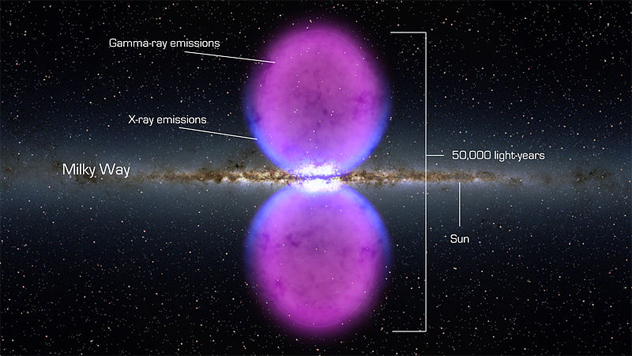
The Milky Way galaxy looks absolutely immense when viewed flat, as we're accustomed to seeing it in illustrations. When viewed edge-on, however, it's underwhelmingly wispy and scrawny looking. Or at least it was, until we looked at it in the extremely short end of the spectrum: X-rays and gamma rays.
从平面看,银河系非常庞大,就像我们经常在图片上所看到的画面一样。但从侧面看,它却十分普通,纤细瘦小。或者至少在我们通过光谱的极短端(X射线和伽玛射线)观察它以前,它是这样的。
The Fermi Bubbles jut out perpendicularly to our galaxy's disc and encompass a length of 50,000 light years, or about half the diameter of the Milky Way. Not even NASA knows for sure where the bubbles came from, but they could be leftover emissions from the supermassive black hole in our galactic core, because gamma radiation is only produced by incredibly energetic events.
费米气泡垂直银河系盘面沿伸50000光年,相当于银河系直径的一半。甚至连美国宇航局都不清楚这两个巨大气泡从何而来。然而他们也许是银河系中心特大质量的黑洞所产生的残余放射物,因为只有巨大的高能事件才会产生伽玛射线。
8.行星"忒伊亚"
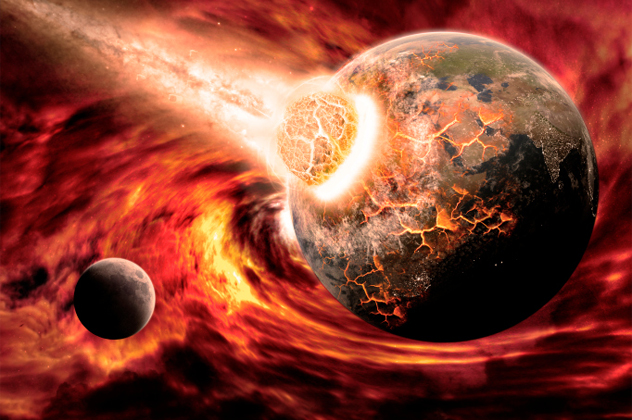
Over four billion years ago, the early Solar System was horrible and extremely dangerous, full of planetoids at different points of development. Our cosmic neighborhood was littered with chunks of rock and ice, so collisions were frequent. The largest of these collisions accounts for one of the more popular theories of how our Moon came about. The primordial Earth was impacted by an object about the size of Mars, named Theia. The two bodies met at a very specific angle, and it is believed that the leftover debris coalesced inside Earth's orbit to form what is now the Moon.
在四十亿年前,早期的太阳系非常恐怖也极端危险,布满了在不同发展阶段的小行星。我们的宇宙附近到处都是石头和冰块,所以碰撞也十分频繁。其中最大的一次碰撞解释了一种人们更加认可的月球形成学说——大碰撞说。原始地球和火星大小般的忒伊亚行星发生了碰撞。它们在一个特殊的角度相撞,据说碰撞后所产生的残骸进入地球轨道,最终合并形成了现在的月球。
Had the impact been slightly more direct, either closer toward the poles or the equator, the results would have been drastically different and the young Earth could have been obliterated completely.
如果撞击稍微再正面一些的话,要么更靠近两级要么更靠近赤道,那么结果将会大不相同,撞击很可能会彻底毁灭年轻的地球。
7.史隆长城
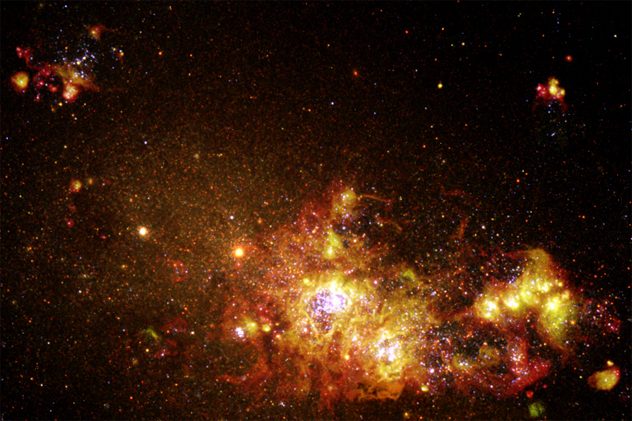
The Sloan Great Wall is mind-bogglingly large and seems absolutely unreal in lieu of the types of size comparisons we humans are accustomed to dealing with. The Great Wall is one of the largest structures in the universe, and is made up of a string of galaxies that stretch for 1.4 billion light years.
与平常我们人类接触过的天体结构相比,史隆长城庞大到令人难以置信,看起来十分不真实。它是宇宙中最大的结构之一,由一连串的星系组成,长达十四亿光年。
It contains hundreds of millions of distinct galaxies, most of which form superclusters within the overall structure. It appears that the clusters have formed in accordance with regions of differing densities that were a direct result of the Big Bang, and are observable in the cosmic microwave background. Some argue that the Sloan Great Wall should not be considered a single structure, due to the fact that not all of the galaxies are gravitationally bound to one another.
史隆长城包含了数以亿计的不同星系,其中大多数在整体结构中形成了超星系团。这些星系团似乎是依照宇宙大爆炸造成的不同密度区形成的,在宇宙微波背景下也可以观测得到。一些人认为史隆长城不应被当成一个单一的结构,因为事实证明并不是所有的星系都是有倾向性地连接在一起的。
6.最微小的黑洞
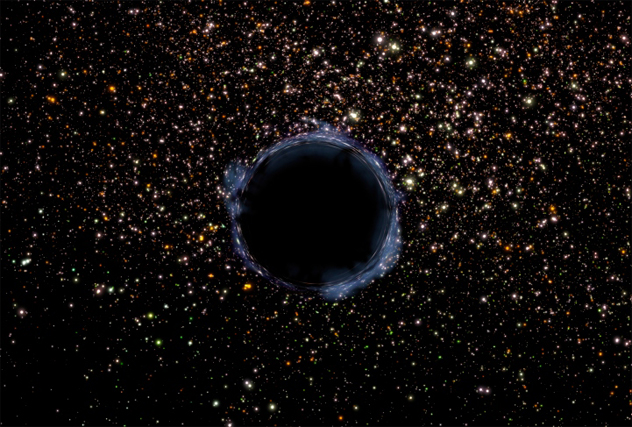
Nothing in the universe inspires as much fear as the mighty black hole. In video game terms it's the "final boss" of the universe. It has enough pull to ensnare light itself, which moves at almost 300,000 kilometers per second (186,000 mi/s). We've seen black holes that are impressively large, at billions of times the mass of our sun, but now for the first time we found one that's impressively puny.
在宇宙中,没有什么能比巨大的黑洞更吓人的了。用电子游戏中的术语来说,它就是宇宙的"终极巨兽"。黑洞产生的引力场如此之强,甚至连以每秒30万公里的速度移动的光也无法逃逸。我们已经目睹过无比巨大的黑洞,他们的质量是我们太阳的数十亿倍。但是现在我们第一次发现如此微小的黑洞。
The previous record holder for smallness was still around 14 times the mass of the Sun, which is quite large for our standards. The new kid, IGR, is only about three times as massive as the Sun. IGR comes in at around the bare minimum of mass necessary to cause a star to fall in on itself when it dies. If it was any smaller it would have gone out as our own Sun will, slowly bloating up before shedding its outer layers and most of its material into space.
在此之前微小记录的保持者大约是太阳质量的14倍,用我们的标准来衡量的话已经相当之大了。这颗最新发现的小黑洞IGR仅是太阳质量的三倍。它接近黑洞稳定存在的质量下限,当它死去时便会自动坠落。如果它更小一些,便会和我们的太阳一样熄灭,渐渐膨胀,最后外层和大多数内部物质脱落,散落在宇宙中。

















